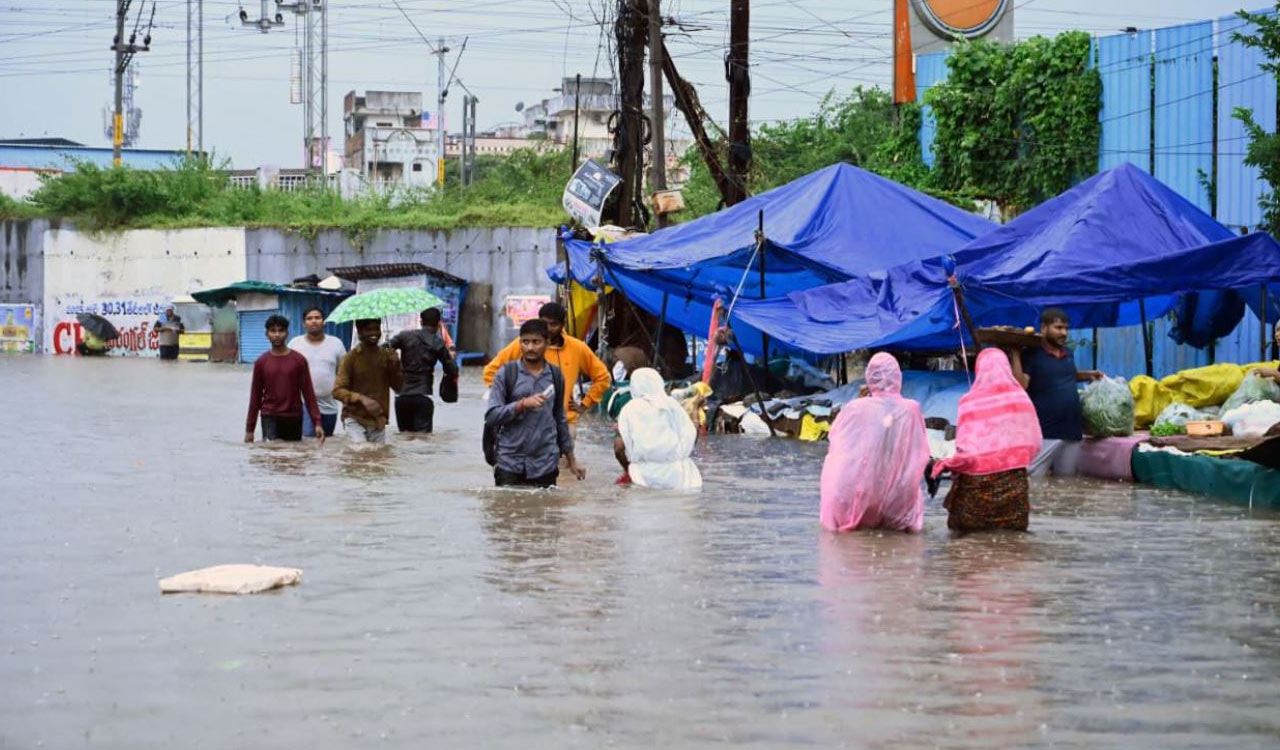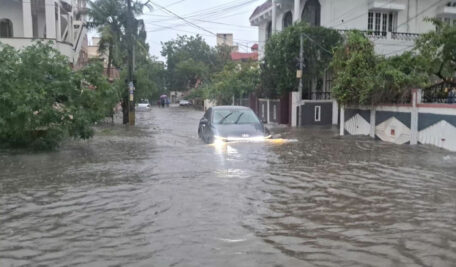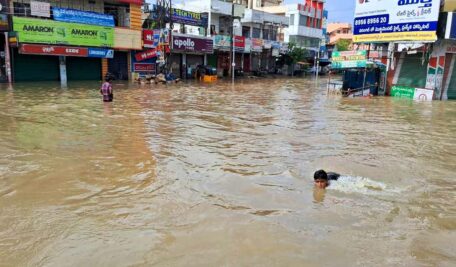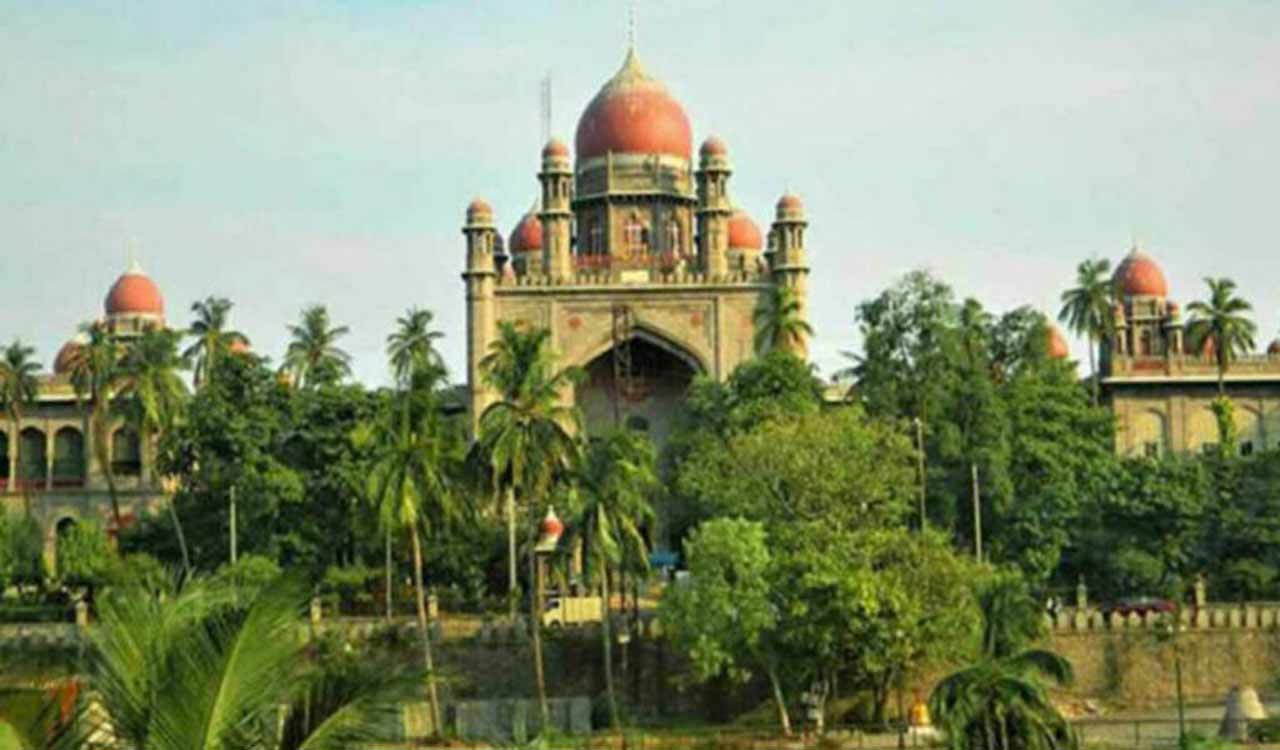Cyclone Montha’s fringe effect wreaks havoc across 16 Telangana districts
The fringe effect of Cyclone Montha caused widespread destruction across 16 Telangana districts, damaging paddy and cotton crops, flooding villages and disrupting daily life. Farmers reported heavy losses as rains hit during the peak harvesting and procurement season

Hyderabad: The fringe effect of Cyclone Montha wreaked havoc across 16 of the 33 districts in the State, leading to heavy losses, particularly to crops during the crucial paddy harvesting and cotton procurement season. The storm’s timing worsened the crisis as harvested grain at procurement centres was exposed and left soaked.
Heavy rainfall ranging from 10 cm to 15 cm, and in some districts up to 37 cm, from Nalgonda to Karimnagar, flattened paddy crops in thousands of acres. Preliminary assessments indicate considerable losses to paddy farmers. The rain havoc was severe in Warangal, Khammam and Nalgonda districts. Farmers like Gadagoni Sudershan in Narsampet mandal reported that entire fields ready for harvest were ruined by strong winds and overflow from nearby irrigation tanks. Harvesting was temporarily halted in affected areas to prevent further losses.
Stocks awaiting procurement at market yards were soaked, leading to quality deterioration. Chillies and other early-stage crops on black soil were also inundated. While exact figures for Telangana are still being compiled, the damage assessment exercise is yet to begin in a full-fledged manner. The State government has directed departments to quantify losses for assistance.
Farmers in Nalgonda, Hanamkonda, Mahabubabad, Warangal, Khammam and Nizamabad districts are reeling under extensive flooding of paddy and other crop fields. Farmers have been urging officials to assess losses and provide immediate relief.
Nalgonda District:
With heavy rains starting on Tuesday evening and continuing through Wednesday, life came to a standstill as midnight downpours in Devarakonda division left local streams swollen, flooding colonies. Chandampet recorded the highest rainfall at 14.01 cm, with the district average at 5.9 cm. Seasonal rainfall from June 1 to October 29 stood at 856.5 mm, 44 per cent above normal. Paddy fields ready for harvest were inundated, while IKP centres with piled-up grain stocks failed to reach out to the farmers.
Cotton crop, already damaged by earlier excess rains, suffered further losses as bolls blackened in fields and stored cotton absorbed moisture. Both the Krishna and Musi rivers received heavy inflows, prompting officials to lift gates. Nagarjuna Sagar released water through four gates following an inflow of 3.97 lakh cusecs. Floodwaters surrounded Kommapalli Gurukul School in Devarakonda, forcing Collector Ela Tripathi and SP Sharath Chandra Pawar to rescue students and staff using ropes.
A pregnant woman in Manampalli was carried across a stream on a stretcher by a 108 ambulance crew. Roads turned inaccessible due to flooding in multiple mandals, with bridges cut off and villages isolated. A toll-free control room was opened at the Collectorate, and officials issued warnings against unnecessary travel.
Hanamkonda:
Bhimadevarapalli mandal in Hanamkonda recorded the State’s highest rainfall at 41.2 cm on Wednesday, filling tanks and streams to the brim. Locals said Mutharam tank, dry for decades, was now overflowing. A tank breach in Kothapalli prompted officials to provide relief, while Kothakonda tank risked a breach. Around 6,030 acres of paddy belonging to 3,290 farmers were damaged, with harvested grains soaked. Roads between Kothakonda-Gatlanarsingapur and Kothakonda-Mallaram were cut off. Bollonipalli village was waterlogged, and 25 families were relocated to anganwadi and school centres after their homes flooded.
Power infrastructure suffered extensive damage — two transformers and 26 poles were affected. Livestock losses included one cow and two calves in Koppur, and two cows in Mallaram. Nearly 94 tanks are at risk. Farmers and residents have been pleading for government support.
Mahabubabad District:
Two days of incessant rains devastated Narsimhulapet mandal in Mahabubabad district. In several areas, cotton sprouted and chilli plants withered due to water stagnation. Bridges like Akeru in Kausalya Devipalli and causeways near Kommula Vancha overflowed, disrupting traffic. Floodwaters entered homes in Buddatanda under Pakir Tanda panchayat. In Dantalapalli mandal, paddy stocks were submerged at harvest centres. Cotton and chilli stocks were also damaged. The Paleru stream overflowed a low-lying bridge near Pedda Mupparam, isolating the village for two days.
Nizamabad:
Rains over the last three days soaked harvested paddy lying on roads, in godowns and fields. Grain stocks in Dichpalli, Bodhan, Dharpalli, Lingampet and Nagireddypet mandals were exposed to rain, with some stocks washed away. Farmers demanded a Rs 500 bonus per quintal for wet paddy and sought immediate supply of tarpaulins at all centres, along with steps to resume procurement.
The cyclone exposed procurement delays and infrastructure gaps. Farmers urged swift enumeration of losses, compensation, and protective measures to salvage what remains of the season. District officials are touring affected areas, but the scale of devastation calls for urgent State intervention, the farmers affected by Montha said.


Related News
-
Uttar Pradesh STF arrests Atique Ahmed’s close aide
1 min ago -
IndiGo CEO Piter Elbers to appear before DGCA
9 mins ago -
Judge to decide degree of media access in Charlie Kirk killing case
15 mins ago -
Trump administration separates thousands of migrant families in US
20 mins ago -
Subramania Bharati illuminated India’s cultural and national consciousness: PM Modi
31 mins ago -
Rupee falls 17 paise to 90.11 amid risk-off sentiment and strong dollar demand
31 mins ago -
Chinese national deported for violating visa norms in J&K
33 mins ago -
Hrithik Roshan: Love people who step into a vortex and let the story take control
43 mins ago




